The Atacama Desert in northern Chile reveals astonishing landscapes at the feet of the Andes Mountains. The Salar de Atacama is about 34 miles south of San Pedro de Atacama. This salt flat covers an area of 1,200 square miles and is roughly 62 miles long and 50 miles wide. It is the third largest flat salt deposit in the world after Salar of Uyuni in Bolivia (4,085 sq. miles) and Salinas Grandes in Argentina (2,300 sq. miles.) The salar has both marshy and dry areas, but the dirt is always a mixture of salt and reddish earth in the process of being separated… The incredible crust of salt and minerals formed by the rise and evaporation of a massive saltwater table offers a kaleidoscope of amazing colors… Unlike the Salar of Uyuni, the Salar of the Atacama is neither ultra-smooth nor ultra-white, but instead made up of crystals and lumps of brownish salt. Water is unable to escape and collects in shallow saline lagoons such as Laguna Chaxa, Barros Negros, Salada, and La Punta. These small lagoons are home to extraordinary wildlife such as Baird’s Sandpiper, the black-tailed stilt and the three Chilean flamingo species, which give their name to a nature reserve: Los Flamencos National Reserve. The Los Flamencos National Reserve was established in 1990 and covers an area of 180,000 acres. Los Flamencos National Reserve is the first case in Chile of the co-management of a protected area by the State and an indigenous people, the “Lickan Antai”. It is a successful strategic alliance that allows everyone to preserve the environment better but also to develop tourism. What to see life in pink (flamingo) ?

The Salar de Atacama offers a kaleidoscope of amazing colors
A splendid flamingo, all pink, delicately shakes a paw and hobbles with muffled steps through the pure water of the Laguna Chaxa. It certainly does not want to disturb the quiet of the altitude, nor distract from the blazing blue of the water where the Andean snowy peaks reflect, and the white salt… In this mineral world, life holds his breath and parsimoniously distributes a touch of sweetness. Flamencos in Spanish, flamengos in Portuguese, fenicotteri in Italian, flamants in French, 弗拉明戈 in Chinese…every tourist passing through San Pedro go in search of the three species of flamingos that populate the Salar de Atacama: the Chilean flamingo (Phoenicopterus chilensis), the Andean flamingo (Phoenicoparrus andinus) and the James’s Flamingo (Phoenicoparrus jamesi.) The James’s flamingo was discovered and named after British businessman and naturalist Henry Berkeley James (1846-1892). All three flamingos live in colonies and share nesting areas. Will you be clever enough to tell Qui Et Qui– a French TV game: “Who and Who” – without the assistance of Marie-Ange Nardi ? Come on, here are some hints for the amateur ornithologist… The James’s flamingo, also known as the Puna Flamingo, has light pink feathers, is smaller than the Andean flamingo and has a delicate walk, a long 8-inch neck, long thin colored red brick legs, and a bright yellow bill with a black tip. It typically measures about 35 inches. The Andean flamingo is the rarest flamingo in the world. It is larger than the James’s flamingo with yellow legs and black tips on its wings, takes on a very reddish-pink color when adult, especially the neck… It is the only flamingo with yellow legs and three-toed feet. Its cousin, the Chilean flamingo, is, at 50 inches, the tallest of the three and recognizable by its greyish legs with pink/red joints and with its half-black bill without any yellow. The Chilean flamingo is the only flamingo to perform a “dance” by spinning around itself and gently patting the area with its paws to force its favorite food, the artemia salina (aquatic crustaceans, a species of brine shrimp living in salt lakes), from the mud. The flamingo’s diet consists of microscopic elements present in the bottom layer of the lagoons, in particular diatoms (planktonic unicellular microalgae) and artemia salinas. A diet rich in the alpha and beta-carotene present in the algae and artemia gives the bird’s feathers their beautiful pink color. Only at the age of 2 or 3 years do the young flamingos turn from gray or white to pink. Although the Flamingo spends a considerable amount of time feeding itself, both day and night, we sometimes have the chance to witness the magical vision of a flock of flamingos that evaporate into the horizon in just a few flaps of feathers. The flamingo can fly up to 37 mph over a distance of several miles, which allows it to move from San Pedro in Chile to Argentina with a stop in Bolivia – all in the same day.
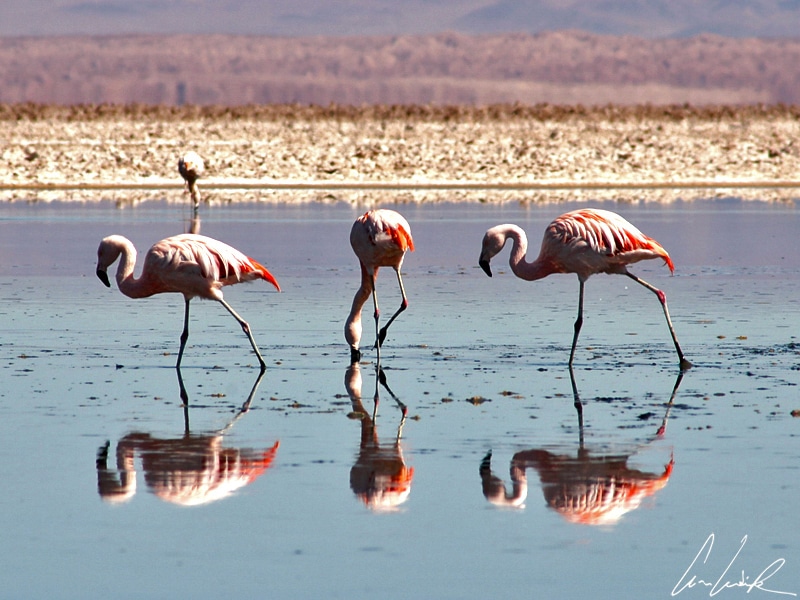
The Chilean flamingo
Chile offers unexpected travel experiences. If you cannot make it to the Dead Sea in Israel, Laguna Cejar (pronounced “Cerar”) is the perfect substitute. Located just 12 miles south of San Pedro the lagoon is surrounded by deep silence with flamingos flying overhead. The high concentration of salt, higher than that of the Dead Sea, in the turquoise waters allows bathers to float effortlessly upon the surface. It is not for nothing that Laguna Cejar is also known as the “floating lagoon”. But in the early morning, the water is too cold (at least for me) to try out the unique sensation of swimming and floating in very salty water. We therefore simply enjoy the view of the lagoon and stare at the peaks of the Licancabur and the Andean volcanoes far beyond the snowy white crust of salt. Once you are tired of floating, and you can try diving at our next destination. We left behind Laguna Cejar with the salt still stuck to our skin and head to Los Ojos del Salar, the blue eyes of the Salar. These two circular freshwater basins with a diameter of about 65 feet each are very deep. They are located on the way to Laguna Tebenquiche. Who cannot resist seeing our own reflection in the bottomless blue of the pool ? Are you tired of lagoons as well as salt ? True that one might think that this “lagoon hunt” is repetitive and tiresome, but this is not the case when the surroundings are so incredible and each place so unique. You are doubtful ? Then we will take you to the exceptional Miñiques and Miscanti lagoons in the foothills of the Cerro Miscanti and the Miñiques volcano. But before climbing to 14,760 feet above sea level, we stop at Tocanao to catch our breath. Tocanao is a small picturesque village 8,153 feet above sea level and located about 22 miles south of San Pedro. The village is a beautiful green oasis along a freshwater river, the Quebrada de Jerez, at the bottom of a small canyon. All kinds of fruits are cultivated along the river: vines, plum trees, fig trees, pear trees… The church of San Lucas is another tourist attraction of the village. The church is located on the town square and dates from 1750. The bell tower, separated from the church, represents God the Father and protects the church. Its door is made of cactus wood and llama leather! Both buildings have been declared National Monuments. The fate of this village of 500 is closely linked to the lithium mine, also known as the source of “white gold”. This open-pit mine was exploited for 20 years by SQM (Sociedad Química y Minera de Chile.) The mine organizes the rhythm of village life, and the town comes alive only in the evening when stray dogs emerge to roam the streets and when the doors of the cantinas open…
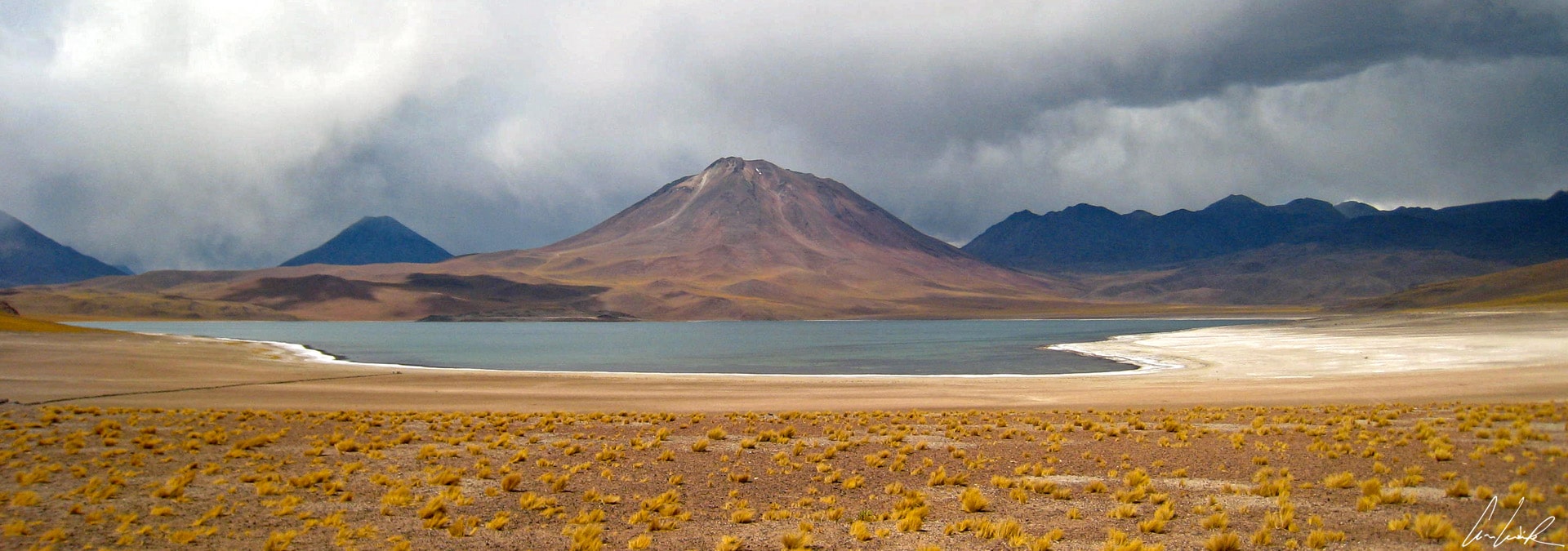
The Miñiques volcano overlooks both Miñiques and Miscanti lagoons from its 19,390-foot high peak
But let’s go back to our “lagoon hunt” and head towards the Miñiques and Miscanti lagoons about 70 miles from San Pedro de Atacama. These two lagoons are an integral part of the Los Flamencos National Reserve. A long “ripio” (gravel) serpentine road winds between the steppes leads to the site, some 13,580 feet above sea level. The road is beautiful. As we go higher the vegetation is sparser. The landscape takes an earth-brown color dotted with “Paja Brava” grass and tufts of dry grass. The sky is clear and takes on a deep blue color, forming a marked contrast to the landscape of red and black rocks and yellow spots of vegetation. Suddenly, the Miscanti lagoon, a large pool of water in the middle of the Atacama Altiplano (about 4 miles long), appears at the end of the road with the Cordón de Puntas Negras in the background. The Cordón de Puntas Negras is a volcanic chain covering 193 sq. miles volcanic chain, and it feeds the Laguna Miscanti year around with an underground flow of water. About 1 mile south of Miscanti Lagoon lies Laguna Miñiques. Once both lagoons formed one big lake, but lava from an eruption of the Miñiques volcano split the lake in two water pools. Under a threatening sky the contrasting colors are spectacular. In this universe of dark rocks and dry yellowish-brown tufts of grass, the two oval-shaped blue lagoons surrounded by snowy white terrain sparkle and fascinate ! Fescues (Festuca orthophylla), well adapted to the high altitude, grow around the lagoon. The Miñiques volcano overlooks both lakes from its 19,390-foot high peak, admiring its own reflection in the crystalline water. As we slowly approach the lake trying to untangle the secrets of such a magical canvas, we stop short so as not to disturb the “Tagua cornuda” (horned coot) nesting on the lakeshore. The horned coot is protected and considered species by the International Union for the Conservation of Nature (IUCN) to be a near-threatened species. Could it be that algae in the water creates a deeper reflection, or does the sun dress the lagoons in gold in contrast to the surrounding dark volcanos? The only signs of life are viscacha (from the Chinchillidae family,) vicuñas, a surprising variety of birds, and, of course, flamingos, which, though common here, are nevertheless rare.

Vicuña
Laguna Miñiques, the smaller sister lagoon, is only 1 mile long, but this does not detract from its charm… The silence is so intense that you could hear it… or almost ! Time passes quickly when looking at such gorgeous vast landscapes, and now it is time to return to San Pedro… On the way back we stop briefly in the small village of Socaire, whose stone church has a pretty thatched roof. It is the only village for miles around and has only 300 inhabitants. This lonely village in the middle of the desert is about 62 miles southwest of San Pedro. How can one live for years in the driest desert of the world? The key to survival is the management of water. Since ancient time, the inhabitants have used terraced farming known as Andenes to grow maize and quinoa. The Andean farming fields surround the village at an altitude of 10,550 feet. The agricultural terraces allow farmers to grow squash, peas, tobacco, potatoes, corn, etc. with an efficient system of irrigation.
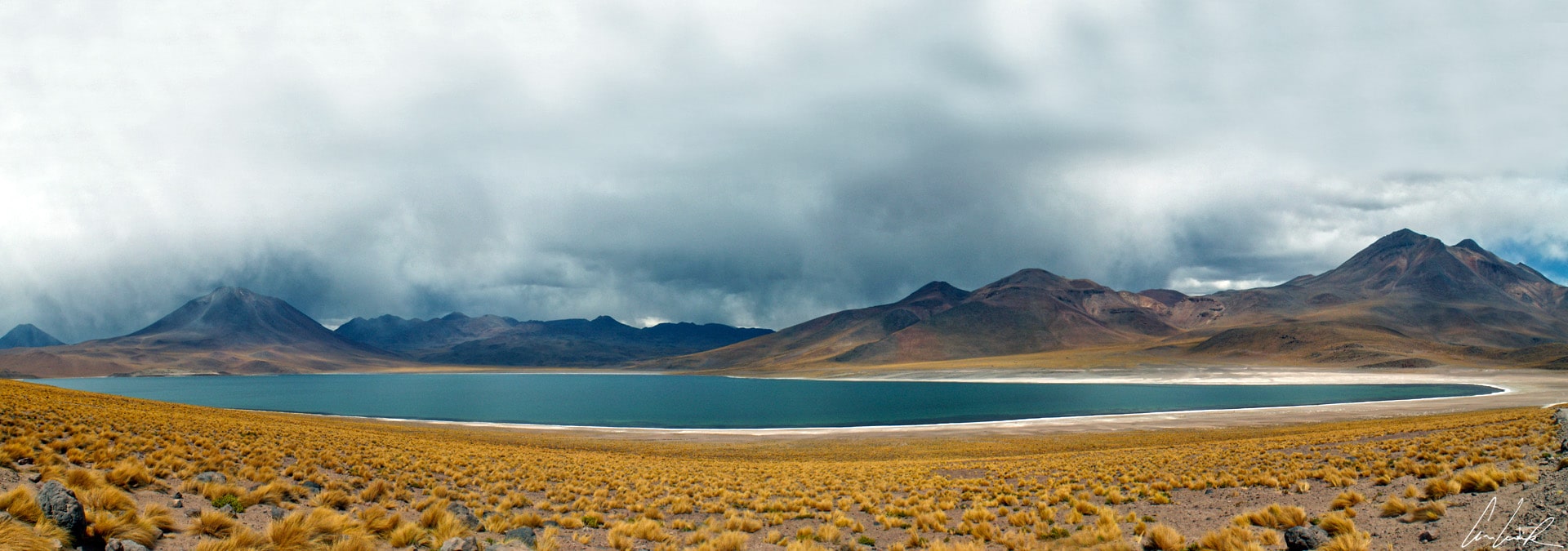


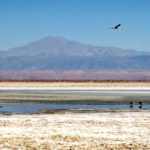


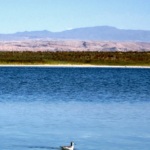



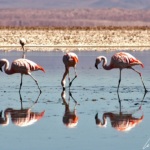
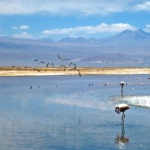

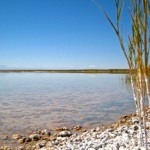

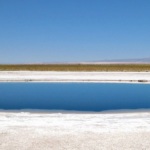
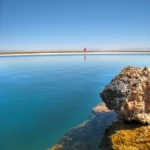

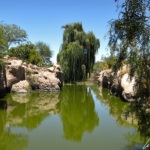
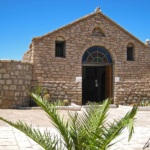


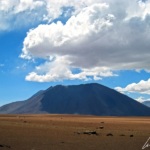
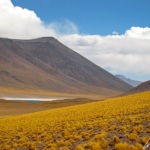
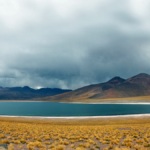
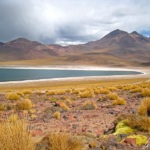
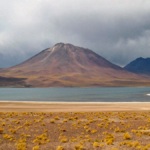

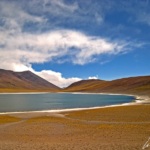




This landscapes look amazing! What was the temperature during the day by they way?
Think of Chile’s wild side and you probably think Patagonia, right ? But like every yin & yang, the South American country of Chile has a flip side too. With its intense blinding sun and high altitude, the Atacama desert is so beautiful 🙂 Temperatures vary depending on the season, elevation and time of day, with highs of 32⁰C/89⁰F at the height of summer.
Wow, I went from sleepy to wide awake reading this! So beautifully written with stunning photos! The Atacama desert looks amazing – I would love to go and see the flamingos!
Thank you 🙂 Beautiful, barren and hauntingly surreal, the otherworldly landscapes of Chile’s Atacama desert are difficult to put into words !
Lagoon hunting definitely doesn’t sound boring especially if these are the views that’ll reward me! I’ve never seen flamingoes up close, btw.. And seeing them on one of these lagoons sounds like a pretty incredible bonus!
Ha, ha thank you Marvi 😉 I knew flamingos were pink and I knew flamingos were big… It wasn’t until viewing them in the wild at Laguna de Chaxa that I realized what a large and beautiful bird they are !
THE ATACAMA DESERT looks stunning. Its just perfect. Flamingoes and lagoons are magical.
The incredible landscape of Chile’s Atacama Desert is like no place on earth 🙂 It was a real treat to see flamingos in flight !
Wow this looks incredibly beautiful! I’ve never travelled to South America before and I think that really needs to change!
And Chile has a wealth of beautiful landscapes beyond the iconic regions of Patagonia and Atacama… It should definitely be on your bucket list. If it’s not, it soon will be… 😉
Wowza! The scenery there looks OH-MAZING and I absolutely love flamingos! I’d really like to add this place to my bucket list! Fantastic photos, too. They should be in a travel magazine!
The amazing landscapes of northern Chile simply beg to be photographed 😉 With it’s unbelievably lagoons and breathtaking natural allures, the Atacama should definitely be on your bucket list !
What a breathtaking landscape of Atacama Desert! And that Flamingo shot looks splendid!
Thank you 🙂 The Atacama desert in northern Chile is some of the most breathtaking landscapes you’ll ever see…
What an amazing place, I adore flamingos – they are such strange creatures. I always feel like they don’t really fit in anywhere and yet could pop up anywhere
Those flamingos received the natural gift of a perfect charming gait – an image of irresistible glamour -as no other bird has on earth. Watching how they move on the salt deposits gives the lovers of birds and ornithologists a true feeling of completeness 😉
Oh now I totally want to pay that place a visit. Your description of it makes me want to pack my bags right now! Lol. This was am interesting post to read. Thank you for sharing.
Thank you 🙂 The Atacama desert is a destination I had been looking forward to for a long time !
Wow, now this is a place that I have never seen before but would absolutely love to. It is so stunning and would be an amazing experience.
The sheer starkness of the Atacama Desert in the north of Chile is one of awe-inspiring beauty 🙂
You have inspired some serious wanderlust for me. I have heard so many great things about Chile, but I think you post just sold me on making it my next destination. Your photos are stunning. The contrast that the salt flats have with the steep mountains in the back is breathtaking.
The Atacama Desert boasts an incredible landscape of ragged, rocky mountains and ravines that are surrounded by towering volcanoes. It is a photographer’s dream destination. This strange yet stunning part of the world feels more alien than familiar, chock full of lagoons, volcanoes and geysers that are far from the norm. The Atacama Desert should definitively on top of your travel bucket list 😉
Those Flamingos are so precious! Your pictures are breathtaking! This was so informative, I’m not a dessert gal myself but I really enjoyed this.
Ha, ha flamingos are the most instantly recognizable wading birds in the world 🙂 They are so pretty!
Wow I’ve never even heard of this place, thank you for introducing me! Your pictures look wonderful 🙂
Thank you 🙂 The Andean flamingos provide a beautiful pink contrast against the brilliant white landscape of the Atacama desert and azure sky !
I didn’t know there were Flamingoes in the Atacama! The mini- Laguna is adorable too. So much great info. Your pictures are amazing too.
Thank you so much 😉 There are plenty of reasons why a visit to the Atacama desert is totally worthwhile … Such as breathtakingly scenic and diverse landscape that includes arid desert, striking salt flats, thermal pools, geysers, marshes, lagoons, towering volcanoes and a clear, limitless sky and of course the flamingos !
Wow. This place looks absolutely stunning! I recently “saw” flamingos for the first time in Peru, but they were so far away that I could barely make them out – would love to see them up close!!!
Flamingos are a familiar sight even to those who have never seen one in real life 😉 Did you see flamingos, in the high Altiplano of the Peruvian Andes ? I heard that you can see some on the way to the Colca Canyon.
Gorgeous, gorgeous, gorgeous scenery! Chile photographs never seem to disappoint and your are no exception. We see flamingos occasionally here in Florida they are such a beautiful and delicate bird. Plus I have never seen a salt flat- on my bucketlist!
Chile is definitively a photographer’s dream destination: the way the light changes on terracotta mountains; the colour of the lagoons; the beautiful pink contrast against the brilliant white landscape of the salt desert and azure sky… As a landscape photographer, the Atacama desert in Chile has always been a dream trip for me 😉
I’m heading to Chile very soon. The Atacama is definitely on my list. However, I somehow missed the part about flamingos. Thanks for sharing.
I’m sure you will enjoy your trip to Chile :-). So don’t miss the Chaxa Lagoon at Los Flamencos National Reserve, with its Chilean and Andean flamingoes !
What an amazing adventure! I expected the flats to resemble the white ones in Bolivia, and was impressed by the lagoons and the diverse life they support. Your pictures are stunning.
Indeed, far from being a desolate, arid wilderness, the Atacama desert is overflowing with life 😉 And fertile oases sustain an astonishing diversity of life here in the world’s driest desert. I’ve visited Southern Bolivia as well few years ago and I’ve really loved the Salar of Uyuni and the Laguna Colorada !!
Atacama desert looks amazing and your pictures are beautiful. It brings out the best in this place. I love Flamingos..They are such pretty birds. Great post..I had to pin it 🙂
It’s impossible not to be moved by the Atacama 🙂 It truly is one of the most astonishing places on earth, more akin to visiting another planet. This vast desert is a breathtaking quiet place, a silence so profound that at the heart of ruckled vermillion ridges you can hear the salt crack in the rocks and flamingos sip on slate-grey lagoons.
Such a pretty place ! And love how you captured the beauty of this place so gracefully.
Thank you ! Chile’s high-altitude desert may be one of the driest places on earth, but there’s a wealth of sites to visit which all enrich the soul 😉
I’ve searched high and low on the internet for an article about the Andean and Chilean flamingo and these protected areas. You have the best information — even more that the organizations that are trying to protect these flamingos! Thank you for the in-depth article and amazing photography!
You are certainly among the best travel writers on the planet!
Thank you so much for your kind words, they mean a lot to me ! It’s an unforgettable journey on which you will be rewarded with spectacular rock formations, hot springs and a lagoons filled with flamingos.